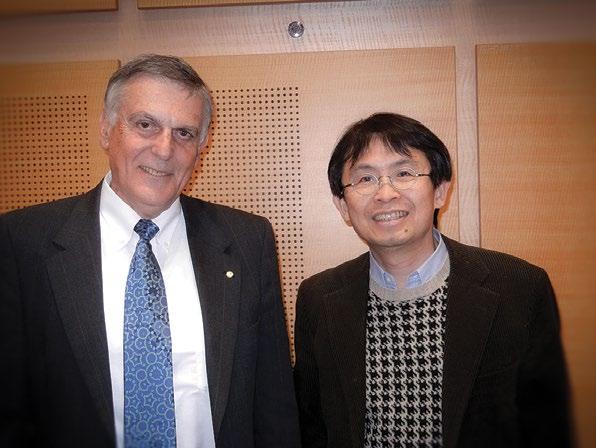
3 minute read
MAKING NEW CATALYSTS FROM UNIQUE METALLIC ALLOYS
Playing with the elements of magnetic alloys can lead to effective industrial catalysts.
Heusler alloys are magnetic materials made from three different metals that are not magnetic individually. The alloys are used broadly for their magnetic and thermoelectric properties, and their ability to regain their original shape after being deformed, known as shape memory. Investigations by Tohoku University’s advanced materials scientist An-Pang Tsai and colleagues now show that these materials can also be fine-tuned to speed up chemical reactions. This catalytic capability is reviewed in the journal Science and Technology of Advanced Materials.
Advertisement
Heusler alloys have a typical composition of two parts metal X, one part metal Y, and one part metal Z (X2YZ). Each of the three come from a distinct region of the periodic table of elements. The original Heusler alloy, discovered in 1898, was Cu2MnAl, made from copper, manganese and aluminium. Many other combinations of metals were later found within the X2YZ arrangement.
While Tsai and his colleagues were investigating another type of structure, called quasicrystals, in the late 1980s, they created a series of new compounds by substituting
existing elements with others from their same groups in the periodic table, as long as they had a similar atomic size. They later applied this concept to fabricate a large number of new Heusler alloys.
Tsai and his colleagues investigated the potential of 12 Heusler alloys as catalysts for propyne hydrogenation, a reaction that is used in the plastics industry, and for the oxidation of carbon monoxide, an important process for controlling pollution. They used relatively inexpensive elements to fabricate their alloys and found promising catalysts that were very selective for propyne hydrogenation. These involved a combination of cobalt for metal X, manganese or iron for metal Y, and gallium or germanium for metal Z. The team suspected that the alloys’ catalytic properties could be fine-tuned for specific target reactions. They also found that metal X is the main active element in these reactions, while elements Y and Z are involved in the catalyst’s activity, selectivity and durability. Some alloys, like one made from cobalt,
titanium and tin, also showed promise for carbon monoxide oxidation.
Tsai and his colleagues believe materials informatics, which uses big data to discover new materials, could be particularly relevant for the discovery of new catalysts from Heusler alloys because of their well-defined arrangement.
Future research is expected to focus on incorporating nanoparticles containing catalytic elements into the crystal lattice of Heusler alloys. This would increase the surface area available for catalytic reactions, improving the material’s catalytic activity.
“It was Professor Tsai’s passion to play with elements and create new materials, with huge successes from early on,” says Alok Singh of Japan’s National Institute for Materials Science. “He has patented his recent works, and we hope to see them in operation in collaboration with industry. In the meantime, his colleagues will keep working on their development, with their progress inspiring further work.”

IN REMEMBRANCE AN-PANG TSAI (1958–2019)
Credit: Alok Singh

Professor An-Pang Tsai (right) discovered the first stable quasicrystal following the research by Israeli Nobel Prize Laureate Dan Shechtman (left) on metastable quasicrystals.
Professor An-Pang Tsai of Japan’s Tohoku University was one of the first scientists to establish the importance of quasicrystals: crystal-like materials with irregularly repeating atomic patterns. Tsai discovered the first stable quasicrystal in 1987 while working on his PhD, after which he discovered many more. His work opened the door for understanding their structures and physical properties. Quasicrystals are now used in a variety of applications, including surgical instruments and LED lights. Professor Tsai received many awards during his illustrious career, including the Medal of Honor with Purple Ribbon by the Government of Japan. Many of his colleagues believe his work warranted a Nobel Prize nomination. Professor Tsai passed away on 25 May 2019 at the age of 60.










